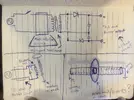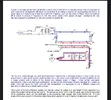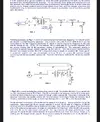IncommensurableLoop
Member
Guys I got a mess of questions and I hope I can get a hand here making some decisions. The picture attached is broken down into 3 parts.
The first (biggest portion of pic) is for high voltage dc roughly 6000v output from a microwave transformer with taking the existing from a microwave and adding a second capacitor and diode to create a full wave doubler output for my primary coil supply
The second picture is a rough draft of the standard Tesla coil circuit.
Third picture is of a rough sketch of what is going on with the creation of the experiment.
-If my plan is to achieve scalar would I even need a toroid?
My guess is no because they cancel fields out so who needs that capacitance. Secondly
-do I have my ground And primary flipped? Should the primary be on the outside and ground towards each other?
I want to achieve high voltage dc pulsing.
From my understanding of a full wave doubler the diodes do prevent any significant drop in voltage but the magnetic field does indeed collapse.
-Therefore it should work with Tesla coils right?
Or is my understanding off and really that magnetic field at the circuit is irrelevant to the magnetic field that actually reaches the primary as it doesn’t carry over the same way?
Tesla coils need a change in magnetic field to operate so this is extremely important to clarify.
-My next question is here. What is proper application for scalar generation the primary in between the two Tesla coils or should I put the primary on the outside end of the Tesla coils?
-Do I need two different power supplies to make this experiment? (Probably if they are on the outside but what about if the primary is in the center, need two or can they share?)
Using the solenoid rule I’m thinking two separate primary and power supplies at the opposite ends so the two can cancel field at the center and generate scalar field. However the reason I ask is that even though it’s the solenoid rule does the direction still apply. Wherever it takes on induction first it will then run the other way down the wire?
-so does this solenoid rule apply to the secondary as well.. based on whichever end receives it first?
Meaning I absolutely need it on the outside to generate the correct direction of field to be able to cancel them both out and get scalar. in theory if the magnetic field causes the Tesla coil to undertake induction which then gives rise to the voltage then therefore wouldn’t only one would matter, no? Using the curl right hand rule it seems most logical to have a primary that is either a double cone shape inverted at the apex -><- like this (where “><“ is the primary and “-“ is the Tesla coil secondary) or just have a larger cylindrical primary -=- (where “=“ is the primary) around the two Tesla coils in the center like a solenoid to power both but only if direction of field didn’t matter from the induction. If it does and they have to be primary on the outside ends then i need to flip it to “<—>” or “=—=“ respecting former legends indicated a few sentences back.
so there’s that. We’ll start with this for now before I go on to some more questions I have about integrating bifilar coils to the schematic if it wasn’t already complicated enough for me lol. But you know. Gotta learn somehow. Thanks for the patience and help for those that do <3
oh and lastly, ** what proper procedures can I take to protect from radiation? A emf shield before operating? Or is it Not a problem when using scalar?
The first (biggest portion of pic) is for high voltage dc roughly 6000v output from a microwave transformer with taking the existing from a microwave and adding a second capacitor and diode to create a full wave doubler output for my primary coil supply
The second picture is a rough draft of the standard Tesla coil circuit.
Third picture is of a rough sketch of what is going on with the creation of the experiment.
-If my plan is to achieve scalar would I even need a toroid?
My guess is no because they cancel fields out so who needs that capacitance. Secondly
-do I have my ground And primary flipped? Should the primary be on the outside and ground towards each other?
I want to achieve high voltage dc pulsing.
From my understanding of a full wave doubler the diodes do prevent any significant drop in voltage but the magnetic field does indeed collapse.
-Therefore it should work with Tesla coils right?
Or is my understanding off and really that magnetic field at the circuit is irrelevant to the magnetic field that actually reaches the primary as it doesn’t carry over the same way?
Tesla coils need a change in magnetic field to operate so this is extremely important to clarify.
-My next question is here. What is proper application for scalar generation the primary in between the two Tesla coils or should I put the primary on the outside end of the Tesla coils?
-Do I need two different power supplies to make this experiment? (Probably if they are on the outside but what about if the primary is in the center, need two or can they share?)
Using the solenoid rule I’m thinking two separate primary and power supplies at the opposite ends so the two can cancel field at the center and generate scalar field. However the reason I ask is that even though it’s the solenoid rule does the direction still apply. Wherever it takes on induction first it will then run the other way down the wire?
-so does this solenoid rule apply to the secondary as well.. based on whichever end receives it first?
Meaning I absolutely need it on the outside to generate the correct direction of field to be able to cancel them both out and get scalar. in theory if the magnetic field causes the Tesla coil to undertake induction which then gives rise to the voltage then therefore wouldn’t only one would matter, no? Using the curl right hand rule it seems most logical to have a primary that is either a double cone shape inverted at the apex -><- like this (where “><“ is the primary and “-“ is the Tesla coil secondary) or just have a larger cylindrical primary -=- (where “=“ is the primary) around the two Tesla coils in the center like a solenoid to power both but only if direction of field didn’t matter from the induction. If it does and they have to be primary on the outside ends then i need to flip it to “<—>” or “=—=“ respecting former legends indicated a few sentences back.
so there’s that. We’ll start with this for now before I go on to some more questions I have about integrating bifilar coils to the schematic if it wasn’t already complicated enough for me lol. But you know. Gotta learn somehow. Thanks for the patience and help for those that do <3
oh and lastly, ** what proper procedures can I take to protect from radiation? A emf shield before operating? Or is it Not a problem when using scalar?



